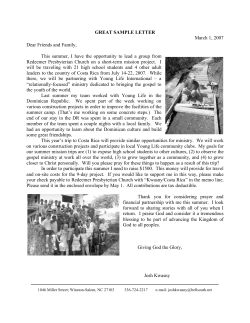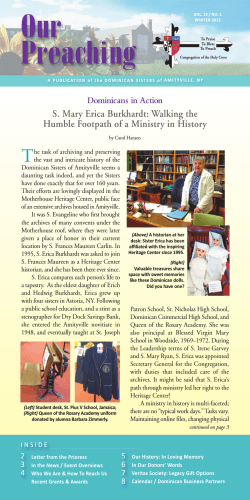
News from Fanjeaux N ° 1 5
S I S T E R H I S T O R I A N S O F T H E O R D E R OF P R E A C H E R S News from Fanjeaux + 33 468788760 shop.fanjeaux@orange.fr http://shop.op.org S.H.O.P. 3 rue du Bourguet Nau 11270 FANJEAUX France N°15 ALL S AINTS 2014 Dominican vocabulary - historical reflections As the 7th November approaches - the date recently designated as one of celebration of and for the Dominican family - it may be helpful to see how the different branches of our family tree were referred to in past centuries. Most of us grew up with the 1, 2, 3 approach, that is to say: 1 = friars, 2 = enclosed nuns and 3 = apostolic sisters and laity. This scheme of things was however not in use before the 19th century, so in an Order as old and venerable as ours, this approach could justifiably be described as a recent invention… and hence due for revision. Attempts have been made, but these old categories still linger on. Nuns are still regularly referred to as “Second Order”. As far as we can judge, the first person to use this appellation was Fr Marie-Ambroise Potton op, who wrote a commentary on the Constitutions of Dominican nuns in the 1860’s. In the prologue we read: “although they go back further in time than the friars, the sisters bear the name of second order, the first rank, as is fitting, being reserved for the male religious.” Heading The Dominican Family protected by the Blessed Virgin, 1510, St Andreas Dominican Church, Cologne, Germany In previous centuries, the approach was different, as is manifested by the title page of a book by the Dominican historian, Jean de Réchac, published in 1635 and entitled: The Lives and Memorable Deeds of Women Saints and Blesseds, Daughters of the First and Third Orders of the Glorious Patriarch St Dominic. Thus by a process of deduction, here it is the friars who constitute the “Second Order”. This same author said of the nuns, in Latin: “sunt Ordinis sed non de Ordine” - a distinction that my knowledge of Latin has never permitted me to grasp. If any of our readers can throw light on this, I would be most grateful. But such distinctions are surely unnecessary, and undesirable. As Fr Bruno Cadoré has written: “The Dominican Family is not primarily a matter for definition, but it is constructed wherever we are learning together to live this joy of carrying the Gospel into the world, by preaching and contemplation”. This concept of family as all inclusive is surely preferable and much to be celebrated. This expression is also used extensively in historical texts, at least from the 17th century onwards, and is by no means a recent invention. S T U D Y T H E H I S T O R Y O F D O M I N I C A N W O M E N : F O L L O W S. H . O . P . D I S T A N C E L E A R NI N G C O UR S E S O N D O M U NI www.domuni.eu N°15 PAGE 2 The Fate of Disaffected Dominican Convents - two examples recently visited Many Dominican convents and monasteries have disappeared from the map over the course of the centuries, as a result of either war, revolution or repressive legislation, and more recently, for the first time in history, simply from a lack of vocations. Many convents were simply demolished, some converted into prisons or army barracks, others into cow sheds or garages. A rather different fate awaited two which have recently entered a new lease of life as gourmet restaurants! Such is the case with the former monastery of nuns at Dinant, Belgium. This community, which goes back to 1895, indeed had its moments of glory, having founded two monasteries in Belgium in the 1920’s, the first monastery of our Order in Japan in 1936, and two missionary congregations for service in the Congo. The sisters left their enormous buildings in the early 1990’s to live together in a “minimonastery” in the grounds of a retirement home. After several false starts, the monastic buildings have now been converted into a restaurant and luxury hotel. The chapel remains intact with its carved choir stalls and stained glass windows of Dominican saints, but now houses… a museum of the history of beer brewing! (Leffe is just down the road in the centre of Dinant). But the most unfortunate aspect of this conversion is that the check-in desk in reception is... the altar from the chapel. Such insensitivity is unfortunate to say the least. When closing convents, perhaps we should ensure that all such “sensitive” items are removed carefully by ourselves before the property goes on the market. The bar and restaurant at “Le Couvent de Bethléem”, Dinant – if only the nuns could see it now... . The conversion job was easier at Collioure, on the French Mediterranean coast, as much of the new restaurant is outdoors, under covered terraces. It is alongside the former conventual church, which, as summer visitors to this beautiful seaside resort will remember, has long housed a winery where the local wines and the Banyuls aperitif are produced. Despite this most secular of uses, the 13th century Dominican church is in a good state of repair; as the winery manager told us, if the vine growers co-operative had not taken it on, the buildings would have fallen into ruins. The cloister is also well preserved, and houses the local museum of modern art. The winery and the new restaurant at the Dominican convent at Collioure, France NEWS FROM F ANJEAUX PAGE 3 Iconography of Dominican Saints - Recent Acquisitions at Fanjeaux The S.H.O.P. Association’s concern for the history of Dominican women is of course mostly oriented towards books and printed material of all kinds. There is however a significant section devoted to the iconography of Dominican women saints and blesseds, particularly those who do not feature prominently in the artistic tradition of the Order. It was in this spirit that S.H.O.P. recently commissioned an icon of St Margaret of Hungary (1242 - 1270) - queen and Dominican nun - from the Monastery of St Catherine of Siena, Drogheda, Ireland. This beautiful icon was written for us by Sr Dominika who was born in Byelorussia, and whose talent and sensitivity for this form of religious art are manifest in this portrayal of the holy nun. Sr Miryam Ana op, who spent some months helping at S.H.O.P. headquarters this year, brought us from a visit to the Czech Republic a beautiful statue of St Zdislava. This was especially made for S.H.O.P. by a young sister of the Czech Dominican Congregation who teaches ceramics in one of their schools. St Zdislava (c.1220 - 1252) is one of the rare saints to be celebrated liturgically as a wife and mother. She was an early member of the Dominican family, and is venerated at the basilica in Jablone, near to her family home at the castle of Lemberk, situated at a point where the three countries, Czech Republic, Poland and Germany converge. The third recent acquisition concerns this time a very well known Dominican saint and brings us back to the seaside and Collioure. On a recent visit there, SHOP members visited the studio of Guylaine Legentil, an artist who continues the tradition of those painters who made Collioure famous in the early 20th century, notably Matisse and the fauvist school. Guylaine’s art is essentially religious, and it is great that in today’s world, this young woman can make a living as a Christian artist. We chose a small watercolour of St Vincent Ferrier - born in Spain but who really lived the life of the itinerant preacher, travelling through many countries of Europe. Tradition has it that he preached in Collioure - which is extremely likely, given its strategic position on the coast road from Spain to France and Italy. Indeed at the time Collioure belonged to the kingdom of Majorca, not France. Given the presence of a Dominican convent (the one that is now a winery!) it would have been an obvious stopping off point for him. In the background of this painting the façade of the Dominican convent of Collioure can be recognised on the shoreline, and St Vincent himself is poised between two impressive towers, representing his preaching mission to the universal Church. 3 rue du Bourguet Nau 11270 FANJEAUX France Phone + 33 4 68788760 E-mail: shop.fanjeaux@orange.fr S.H.O.P. office holders: PRESIDENT Sr Mary O’Driscoll op (Cabra, Dublin, Ireland) SECRETARY Sr Patricia Dougherty op (San Rafael, California, USA) TREASURER Sr Barbara Beaumont op (Fatima, Portugal) The Association of Sister Historians of the Order of Preachers is defined in its statutes as: “a resource for documentation, communication and formation at the service of Dominican women, religious and lay, through the study of their histories.” Statutes Recent visitors On Sunday 19th October, in the context of the visitation of the parish of St Dominique-enLauragais, to which Fanjeaux belongs, by the Bishop of Carcassonne, Mgr Alain Planet, the S.H.O.P. Association was invited to send two representatives to a lunch for the religious of the parish. This took place at the old Dominican convent in Fanjeaux. After the meal, Mgr Planet kindly accepted an invitation to visit the S.H.O.P. house. He seemed very interested in our library (he has a great personal interest in history), and found the house “well suited to purpose”. Recent books We recommend to our readers this recent publication of the Dominican Nuns of Summit NJ: Become a member of the S.H.O.P. Association! It is easy! Send us a note of your name and address (by e-mail or by post) and send 20€ (by post - cash or cheque - or by bank transfer). You will then receive our newsletter regularly and be informed of publications and events. You can also make use of the facilities—accommodation and library — at Fanjeaux. All donations are most gratefully received — they go towards acquiring new books for the library devoted to the history of Dominican women. To Courageously Know and Follow After Truth—the life and work of Mother Catherine Abrikosova by Sr Mary of the Sacred Heart op $ 9.95 Available from Amazon It tells the courageous story of a married couple, the Abrikosovs; the husband became a priest of the Byzantine rite Catholic church and his wife founded a Dominican Congregation, also of the Byzantine rite. This book recounts their many difficulties, first in Tsarist Russia, then under the Bolshevik regime. The sisters were mostly sent to prison camps where they suffered great depravation and many died. The author of this very readable account is a Dominican nun of the Monastery of St Jude, Marbury, Alabama. She spent several months in Russia exploring the possibilities for a new foundation. We’re on the web! http://shop.op.org For donations and subscriptions : Sœurs Historiennes Ordre des Prêcheurs La Banque Postale, Montpellier— please contact us for details.
© Copyright 2025



















